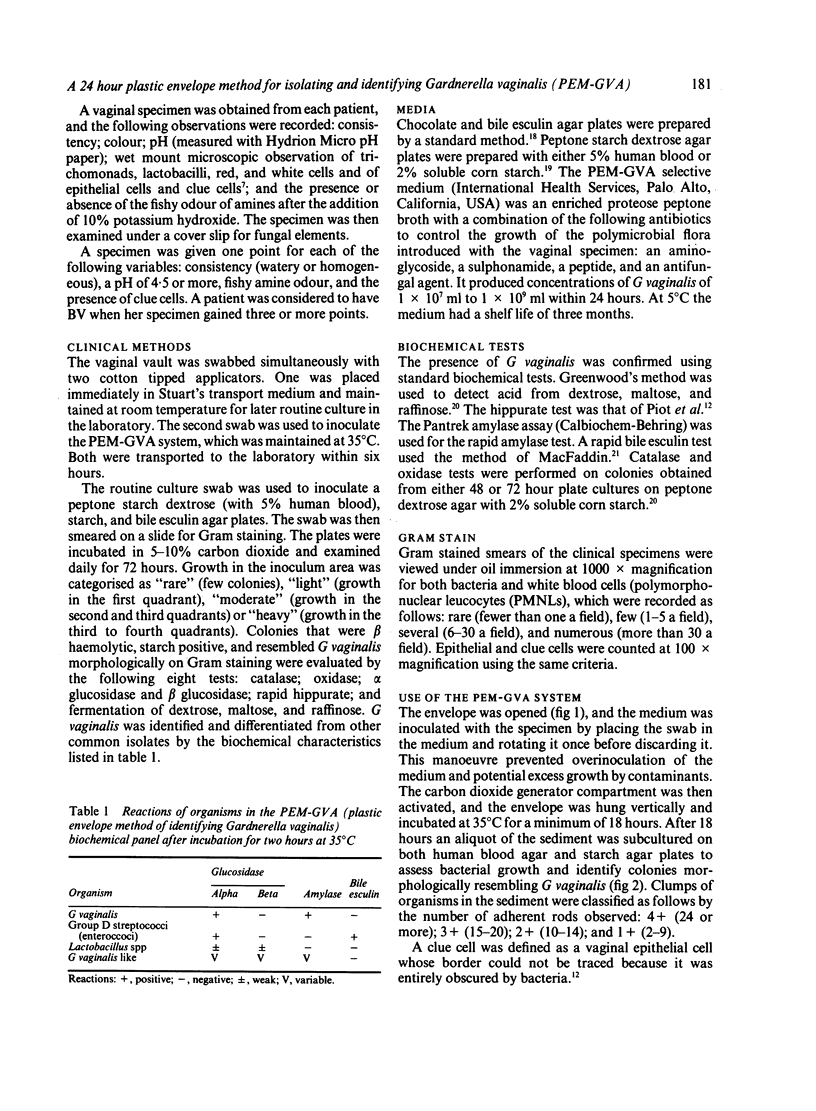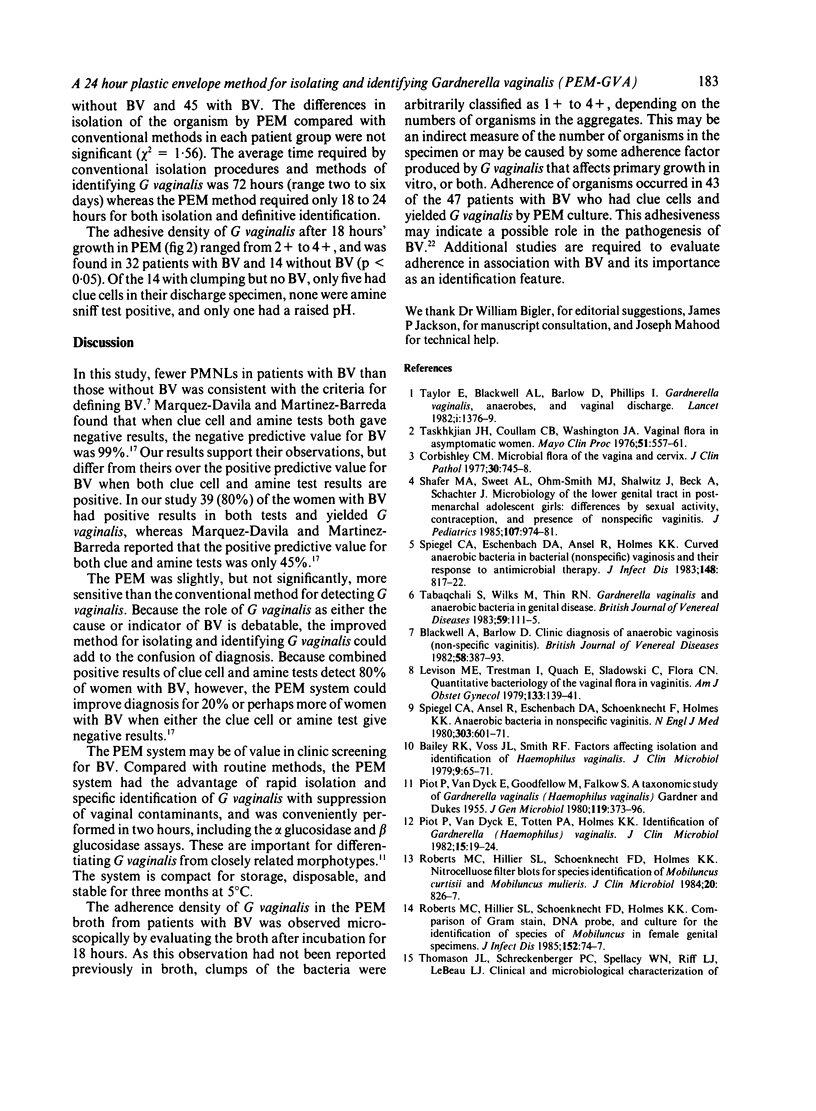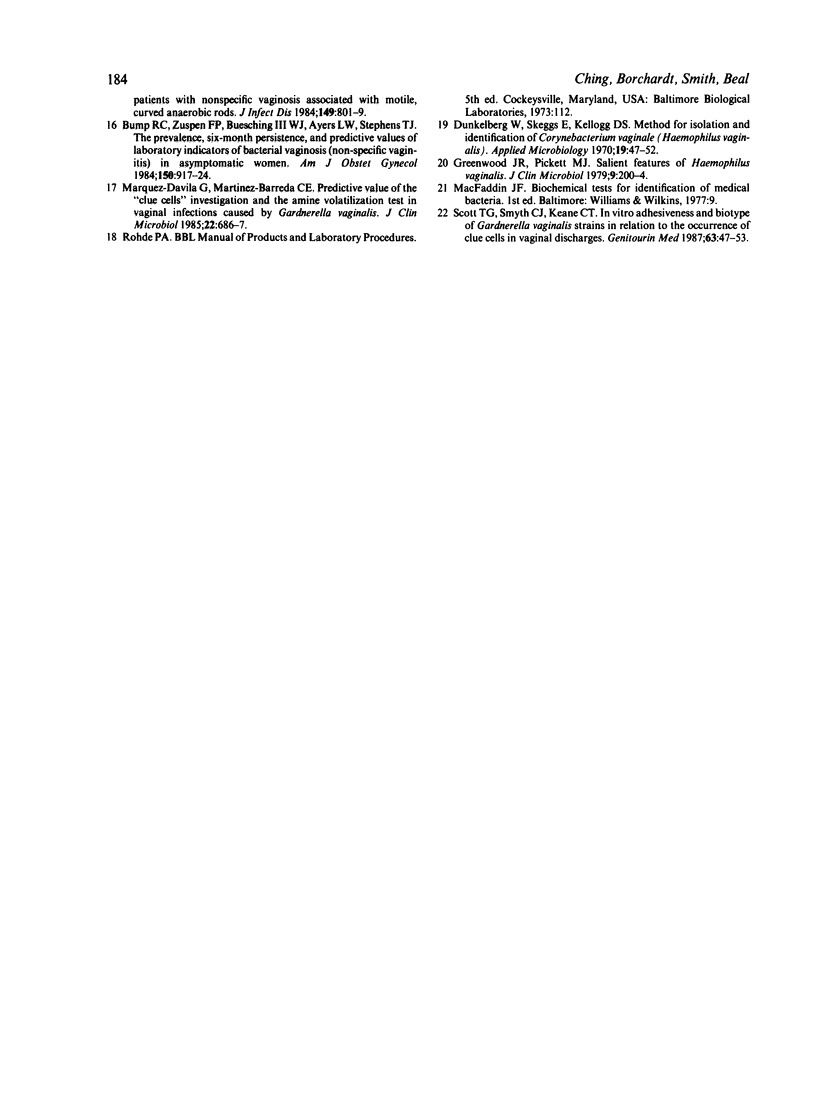Abstract
A new plastic envelope culture test that is selective for Gardnerella vaginalis was compared with a conventional method. Vaginal specimens from 92 women were cultured. Results from both methods were compared with the results of pelvic examinations and clinic screening tests used to diagnose bacterial vaginosis (BV). G vaginalis was isolated more often in the envelope than by the conventional method from patients with BV and those without, though the difference was not significant. Isolation and identification of G vaginalis was completed in 18-24 hours by the envelope method; the conventional method took a mean of 72 hours (range two to six days). Polymorphonuclear leucocytes (PMNLs) occurred significantly more in specimens from the patients without BV than from those with BV. Both clue cells and a positive amine test reaction were found significantly more in specimens from patients with BV than from those without BV. Clue cells and G vaginalis isolation correlated best with BV (in 47 women), followed by clue cells and positive amine test results (in 39). Adherence of G vaginalis in the envelope also correlated more with BV, clue cells, and positive amine test results (32) than with patients without BV (14). When there were no clue cells and amine test results were negative the results correlated totally with a prediction of no BV. The use of the rapid envelope culture test would have confirmed BV in 20% of the cases where clue cell and amine test results were discordant.
Full text
PDF




Images in this article
Selected References
These references are in PubMed. This may not be the complete list of references from this article.
- Bailey R. K., Voss J. L., Smith R. F. Factors affecting isolation and identification of Haemophilus vaginalis (Corynebacterium vaginale). J Clin Microbiol. 1979 Jan;9(1):65–71. doi: 10.1128/jcm.9.1.65-71.1979. [DOI] [PMC free article] [PubMed] [Google Scholar]
- Blackwell A., Barlow D. Clinic diagnosis of anaerobic vaginosis (non-specific vaginitis). A practical guide. Br J Vener Dis. 1982 Dec;58(6):387–393. doi: 10.1136/sti.58.6.387. [DOI] [PMC free article] [PubMed] [Google Scholar]
- Corbishley C. M. Microbial flora of the vagina and cervix. J Clin Pathol. 1977 Aug;30(8):745–748. doi: 10.1136/jcp.30.8.745. [DOI] [PMC free article] [PubMed] [Google Scholar]
- Dunkelberg W. E., Jr, Skaggs R., Kellogg D. S., Jr Method for isolation and identification of Corynebacterium vaginale (Haemophilus vaginalis). Appl Microbiol. 1970 Jan;19(1):47–52. doi: 10.1128/am.19.1.47-52.1970. [DOI] [PMC free article] [PubMed] [Google Scholar]
- Greenwood J. R., Pickett M. J. Salient features of Haemophilus vaginalis. J Clin Microbiol. 1979 Feb;9(2):200–204. doi: 10.1128/jcm.9.2.200-204.1979. [DOI] [PMC free article] [PubMed] [Google Scholar]
- Kobayashi S., Yamaya S. I., Sugahara T., Matuhasi T. Microcapsule agglutination test for Treponema pallidum antibodies. A new serodiagnostic test for syphilis. Br J Vener Dis. 1983 Feb;59(1):1–7. doi: 10.1136/sti.59.1.1. [DOI] [PMC free article] [PubMed] [Google Scholar]
- Levison M. E., Trestman I., Quach R., Sladowski C., Floro C. N. Quantitative bacteriology of the vaginal flora in vaginitis. Am J Obstet Gynecol. 1979 Jan 15;133(2):139–144. doi: 10.1016/0002-9378(79)90464-2. [DOI] [PubMed] [Google Scholar]
- Marquez-Davila G., Martinez-Barreda C. E. Predictive value of the "clue cells" investigation and the amine volatilization test in vaginal infections caused by Gardnerella vaginalis. J Clin Microbiol. 1985 Oct;22(4):686–687. doi: 10.1128/jcm.22.4.686-687.1985. [DOI] [PMC free article] [PubMed] [Google Scholar]
- Piot P., Van Dyck E., Totten P. A., Holmes K. K. Identification of Gardnerella (Haemophilus) vaginalis. J Clin Microbiol. 1982 Jan;15(1):19–24. doi: 10.1128/jcm.15.1.19-24.1982. [DOI] [PMC free article] [PubMed] [Google Scholar]
- Piot P., van Dyck E., Goodfellow M., Falkow S. A taxonomic study of Gardnerella vaginalis (Haemophilus vaginalis) Gardner and Dukes 1955. J Gen Microbiol. 1980 Aug;119(2):373–396. doi: 10.1099/00221287-119-2-373. [DOI] [PubMed] [Google Scholar]
- Reingold A. L., Dan B. B., Shands K. N., Broome C. V. Toxic-shock syndrome not associated with menstruation. A review of 54 cases. Lancet. 1982 Jan 2;1(8262):1–4. doi: 10.1016/s0140-6736(82)92552-1. [DOI] [PubMed] [Google Scholar]
- Roberts M. C., Hillier S. L., Schoenknecht F. D., Holmes K. K. Comparison of gram stain, DNA probe, and culture for the identification of species of Mobiluncus in female genital specimens. J Infect Dis. 1985 Jul;152(1):74–77. doi: 10.1093/infdis/152.1.74. [DOI] [PubMed] [Google Scholar]
- Roberts M. C., Hillier S. L., Schoenknecht F. D., Holmes K. K. Nitrocellulose filter blots for species identification of Mobiluncus curtisii and Mobiluncus mulieris. J Clin Microbiol. 1984 Oct;20(4):826–827. doi: 10.1128/jcm.20.4.826-827.1984. [DOI] [PMC free article] [PubMed] [Google Scholar]
- Scott T. G., Smyth C. J., Keane C. T. In vitro adhesiveness and biotype of Gardnerella vaginalis strains in relation to the occurrence of clue cells in vaginal discharges. Genitourin Med. 1987 Feb;63(1):47–53. doi: 10.1136/sti.63.1.47. [DOI] [PMC free article] [PubMed] [Google Scholar]
- Shafer M. A., Sweet R. L., Ohm-Smith M. J., Shalwitz J., Beck A., Schachter J. Microbiology of the lower genital tract in postmenarchal adolescent girls: differences by sexual activity, contraception, and presence of nonspecific vaginitis. J Pediatr. 1985 Dec;107(6):974–981. doi: 10.1016/s0022-3476(85)80208-0. [DOI] [PubMed] [Google Scholar]
- Spiegel C. A., Amsel R., Eschenbach D., Schoenknecht F., Holmes K. K. Anaerobic bacteria in nonspecific vaginitis. N Engl J Med. 1980 Sep 11;303(11):601–607. doi: 10.1056/NEJM198009113031102. [DOI] [PubMed] [Google Scholar]
- Spiegel C. A., Eschenbach D. A., Amsel R., Holmes K. K. Curved anaerobic bacteria in bacterial (nonspecific) vaginosis and their response to antimicrobial therapy. J Infect Dis. 1983 Nov;148(5):817–822. doi: 10.1093/infdis/148.5.817. [DOI] [PubMed] [Google Scholar]
- Tashjian J. H., Coulam C. B., Washington J. A., 2nd Vaginal flora in asymptomatic women. Mayo Clin Proc. 1976 Sep;51(9):557–561. [PubMed] [Google Scholar]
- Thomason J. L., Schreckenberger P. C., Spellacy W. N., Riff L. J., LeBeau L. J. Clinical and microbiological characterization of patients with nonspecific vaginosis associated with motile, curved anaerobic rods. J Infect Dis. 1984 May;149(5):801–809. doi: 10.1093/infdis/149.5.801. [DOI] [PubMed] [Google Scholar]




